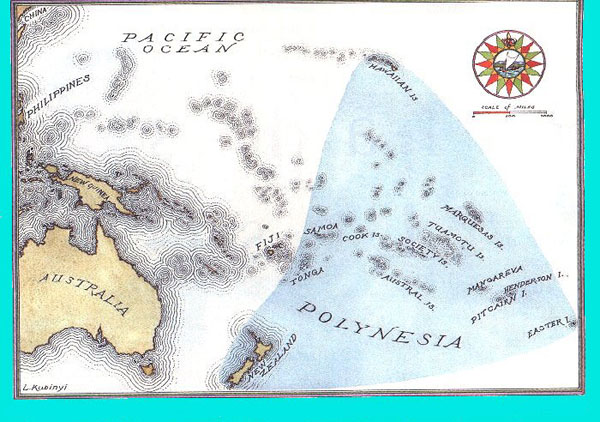AOTEAROA --- the Land of the Long White Cloud.
Contrary to popular belief, the earliest settlers of New Zealand was
not Captain James Cook but were actually ancestors of the Maori from the
Polynesian Islands. They came in huge canoes, bringing with them their
rich culture and heritage that lives on till today.

Before the Polynesians arrived, there were no mammals ashore until they released rats and dogs they had brought with them. They could have brought with them pigs and fowls, but these did not survive in the climate. The lack of food was made up by the large supply of seafood; fish, crab, seaweed, dolphins, seals, among others. There were near to 200 species of birds, most of them edible. They also cultivated the crops they had brought with them; sweet potato, yam, gourds, mulberry and others. There was no worry for a shortage of food.

The New Zealand trees were bigger than what the Polynesians had previously
seen and with them, they built bigger canoes and a complex tradition of
carving evolved. Later, they used the trees as structural beams. Materials
such as raupo and nikau made
excellent house walls and roofs. Flax also plaited
well into baskets and provided fine fibre for garments. There was a sufficiency
of suitable carving materials and tools. Through these artefacts and crafts,
the New Zealand Polynesians developed one of the world's most sophisticated
Neolithic culture.
Many of the Polynesians became hunters, gatherers, and cultivators.
The Moa, a four metre tall flightless bird, was a much hunted animal as
it was very huge and provided food enough for days. However, it's exploitation
soon led to it's extinction.

Competitive tribalism was an accepted way and basis of the Maori life.
The whole of life to Maori was unified in which every aspect of life is
related to every other. Art, religion, war, food gathering, love-making,
death were all an integrated pattern on a single fabric --an intricate
piece of tapestry. Universal acceptance of concepts like sacredness, spiritual
authority, life force, satisfaction and a belief in sorcery regulated all
these aspects of life.
There is a hierarchy system in the Maori tribe. People were either
born into chiefly families or as commoners. They became slaves if they
were captured in a war. Society was divided into two classes. The upper
class composed of the highest nobles and the military generals or chiefs.
The lower class was made of commoners. Those outside these classes were
slaves who held no rights. They did menial work and often died as sacrificial
victims or to provide food when special events required human flesh.
Whole communities which shared a common ancestor were under the jurisdiction
of a family who earned the authority partly from hereditary and partly
from past achievement. Tribes would sometimes join forces against a foreign
element or to search or trade resources. Communities range from a handful
of households to more than 500 living in villages. The village would be
close to water, food resources and cultivations. Maori settlements were
constricted with an interior stronghold, ditches, banks and palisades.
Some of these defences were impregnable while others were easily broken
into and taken away. Communal patterns of life in Maori settlements were
organized around food growing, food gathering and in areas of frequent
fighting, warfare. Large parties of workers carry out cultivation and the
search of food seasonally. When there is a shortage of food items, there
is a prohibition laid on the people.
Warfare is an important competitive feature of Maori life in most parts
of the country. It is carried out to obtain territory with food or other
natural resources, to avenge insults; either real or imagined, to obtain
satisfaction from sub-tribes whose members have broken the social code.
And sometimes as a result of serious disagreements over control or authority.
Such reasons were often lame and could be nurtured from generation
to generation. The important factor, however was that wars or rumours of
it kept tribes alert and strong. It also brought about the destruction
of sub-tribes which did not possess these qualities. However war did not
bring about much destruction prior to the introduction of the musket as
it often only involved individuals or small raiding parties. Even when
larger parties met for confrontation, the numbers of deaths amounted to
only a few. Fighting never occurred far from the home territory. Therefore
it was only carried out during the summer months, except when migration
was underway.
Although warriors receive high standing and respect, it was possible
also to achieve high standings in the arts or as priests as these people
were given the same treatment as warriors. And only priests and Maoris
from higher ranks were allowed to carry out tattooing. The Maoris had many
beautiful pieces of art which can be found in museums. One example can
be seen in the canoes which they use extensively as a form of transport.
In many aspects, the lives of the Maoris were short and brutish. There
was always the danger of being tortured or killed as a result of warfare.
There was also ritual cannibalism the possibility of disinheritance and
enslavement in defeat. Furthermore, research shows that the life-spans
of the Maoris seldom exceed 30 years. From the late twenties, people would
have suffered from numerous diseases. The Maoris also had no concept of
nationhood or race, having been so long separated from other races and
cultures. They were fiercely assertive of their ancestry. But they were
happy as they went along with their life in the land they called Aotearoa
which the white men were soon to invade...
Raupo -- Bulrush, a tall grasslike
waterside plant
Nikau -- A type of palm tree
Flax -- the thread made from the stems
of a flax plant